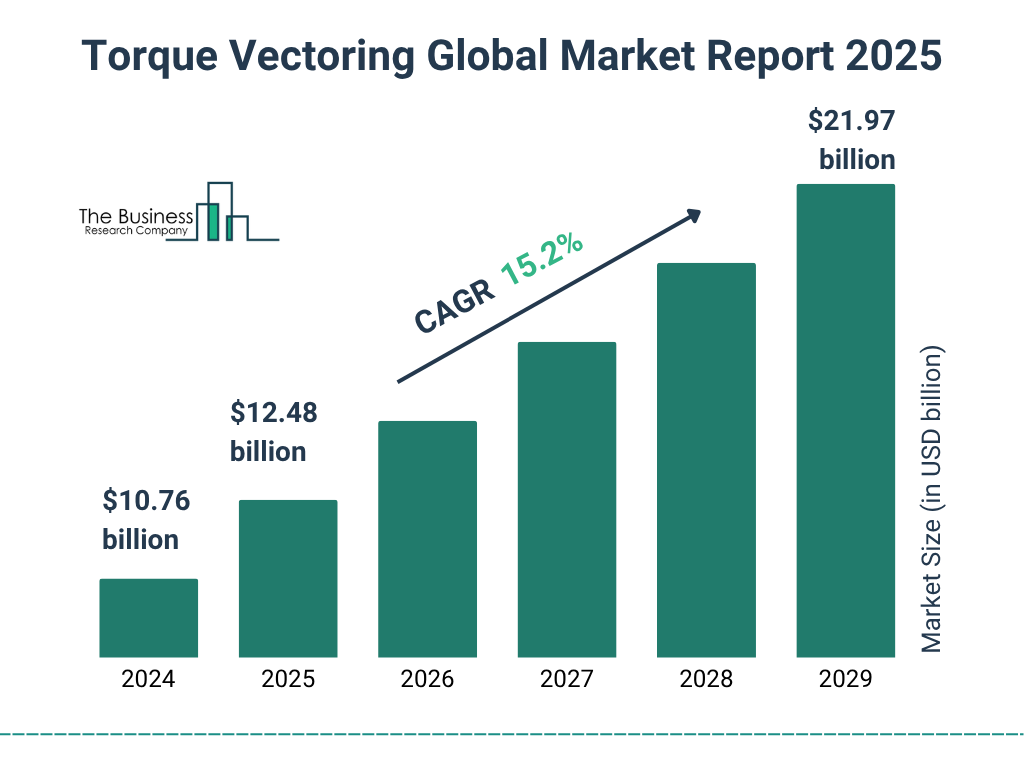Torque Vectoring Market is Projected to Grow Expeditiously: to Reach $21.97 Billion by 2029

For organizations targeting expansion, this report delivers actionable intelligence on how the torque vectoring industry is evolving.
How Much Is The Torque Vectoring Market Worth?
The torque vectoring market size has grown rapidly in recent years. It will grow from $10.76 billion in 2024 to $12.48 billion in 2025 at a compound annual growth rate (CAGR) of 15.9%. The growth in the historic period can be attributed to improved traction and stability, safety enhancement, market competitiveness, consumer demand for enhanced driving dynamics, environmental and fuel efficiency concerns.
The torque vectoring market size is expected to see rapid growth in the next few years. It will grow to $21.97 billion in 2029 at a compound annual growth rate (CAGR) of 15.2%. The growth in the forecast period can be attributed to autonomous vehicle development, urban mobility solutions, regulatory compliance and safety standards, cybersecurity integration, rise of rear-wheel torque vectoring. Major trends in the forecast period include advanced sensor technologies for precise control, ai-based torque vectoring algorithms, integration with vehicle stability control, customizable driver settings, collaboration with tire manufacturers.
Get your free sample today:
https://www.thebusinessresearchcompany.com/sample.aspx?id=13197&type=smp
What Are The Current Leading Growth Drivers For Torque Vectoring Market?
The growing trend of autonomous vehicles is expected to boost the growth of the torque vectoring market going forward. An autonomous vehicle refers to a vehicle that can function independently of human control. It uses various sensors, such as radar, lidar, and cameras, to create a map of its surroundings. Torque vectoring helps autonomous vehicles become more energy efficient by minimizing the power lost to wheel slide and other inefficiencies. For instance, in December 2022, according to a report published by the Insurance Institute for Highway Safety, a US-based non-profit organization, there were projected to be 3.5 million autonomous vehicles on American roads by 2025. Further, 4.5 million autonomous vehicles will be on the road by 2030. Therefore, the growing trend of autonomous vehicles is driving the growth of the torque vectoring market.
Which Segment Accounted For The Largest Torque Vectoring Market Share?
The torque vectoringmarket covered in this report is segmented —
1) By Clutch Actuation Type: Hydraulic Clutch, Electronic Clutch
2) By Vehicle Type: Light Commercial Vehicles, Heavy Commercial Vehicles, Passenger Car
3) By Propulsion: Front Wheel Drive (FWD), Rear Wheel Drive (RWD), All Wheel Drive (AWD) Or Four Wheel Drive (4WD)
4) By Technology: Active Torque Vectoring System (ATVS), Passive Torque Vectoring System (PTVS)
Subsegments:
1) By Hydraulic Clutch: Conventional Hydraulic Clutch Systems, Advanced Hydraulic Actuation Systems
2) By Electronic Clutch: Electrohydraulic Clutch Systems, Fully Electric Clutch Systems
Torque Vectoring Market Emerging Trends And Opportunities
Major companies operating in the torque vectoring market are focused on developing technologies such as advanced E-Powertrain technologies to enhance vehicle performance, improve energy efficiency, and provide superior handling and stability in various driving conditions. Advanced E-Powertrain technologies refer to integrated electric powertrains that combine electric motors, batteries, and control systems to optimize energy efficiency and performance. For instance, in June 2022, GKN Automotive, a UK-based automotive industry company manufacturer of driveline components, launched a next-generation inverter. The next-generation inverter is a significant advancement in electric vehicle (EV) technology designed to enhance performance and sustainability. This new inverter is a key component of GKN’s modular eDrive platform and is compatible with both 800V and existing 400V systems, making it versatile for various OEM applications. The new inverter offers a 20% increase in power output compared to its predecessor, enhancing the overall efficiency of electric drivetrains.
Which Are The Top Companies To Hold The Market Share In Torque Vectoring Market?
Major companies operating in the torque vectoring market report are Robert Bosch GmbH, Tesla Inc., Audi AG, ZF Friedrichshafen AG, Continental AG, Magna International Inc., Eaton Corporation, Mitsubishi Motors Corporation, Schaeffler AG, BorgWarner Inc., JTEKT Corporation, Denso Corporation, Dana Incorporated, Linamar Corporation, GKN Automotive Limited, American Axle & Manufacturing Inc., Haldex Ltd., Ricardo PLC, Univance Corporation, Prodrive Holdings Ltd., Getrag B.V. & Co. KG, Koenigsegg Automotive AB, Modelon AB, Drako Motors Inc., Hofer Powertrain GmbH
View the full torque vectoring market report here:
https://www.thebusinessresearchcompany.com/report/torque-vectoring-global-market-report
Which Region Is Projected To Account For The Largest Share Of The Torque Vectoring Market?
North America was the largest region in the torque vectoring market in 2024. Europe is expected to be the fastest-growing region in the forecast period. The regions covered in the torque vectoring market report are Asia-Pacific, Western Europe, Eastern Europe, North America, South America, Middle East, Africa
#Contact Us:#
The Business Research Company
https://thebusinessresearchcompany.com/
Americas +1 310–496–7795
Asia +44 7882 955267 & +91 8897263534
Europe +44 7882 955267
Email: info@tbrc.info
#Follow Us On:#
LinkedIn: https://in.linkedin.com/company/the-business-research-company


Comments
Post a Comment